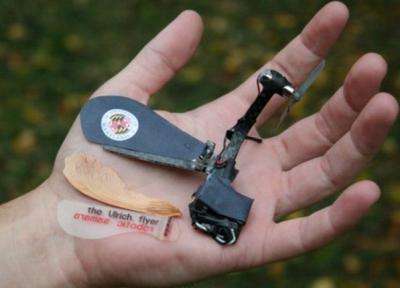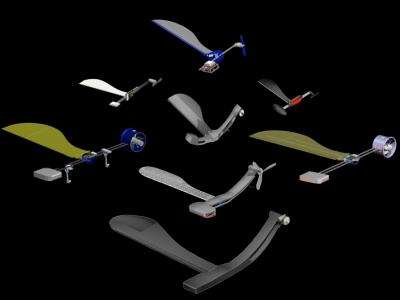January 25, 2011 feature
Researchers build flying robotic 'tree helicopter' (w/ Video)

(PhysOrg.com) -- Many trees disperse their seeds by releasing "helicopters," those single-winged seeds that are also called "samaras." As these seeds fall to the ground, their wing causes them to swirl and spin in a process called autorotation, similar to man-made helicopters. In a new study, researchers have designed and built a mechanical samara whose dynamics are very similar to those of nature’s samaras. After testing the mechanical samara, the researchers then built a variety of remote-controlled robotic samaras with onboard power sources.
The researchers, Evan Ulrich, Darryll Pines, and Sean Humbert from the University of Maryland, have published their study on the robotic samaras in a recent issue of Bioinspiration & Biomimetics. The idea for building a flying robotic device based on samaras originated several years ago, after researchers attempted to scale down full-size helicopters.
“Full-scale helicopters have a high aerodynamic efficiency,” Ulrich, a PhD candidate, told PhysOrg.com. “But the aerodynamic efficiency is disproportionate, so a scaled-down helicopter has stability issues and is unfeasible. Dr. Pines, my advisor, realized that the simplest system in nature that achieves vertical flight and can autorotate like a helicopter is the samara, which is a naturally stable system.”
After further investigating the samara in order to better understand its flight dynamics, the researchers found that the winged seed is also one of nature’s most efficient fliers. The samara is a monocopter, meaning it has a single wing. For this reason, the samara has no stationary frame of reference, unlike a two-winged helicopter, and appears to fall in a complex way. However, through free-fall testing, the researchers could quantitatively measure the samara’s flight dynamics and use this information to control the samara’s autorotation and flight path.
After designing and building a mechanical samara, the researchers measured its flight dynamics in free-fall by dropping it from a height of 12 meters. Then the scientists used this data to develop three different designs of powered robotic samaras, ranging in size from 7.5 cm to 0.5 m. In flight tests, they demonstrated that the carbon fiber-based robotic samaras could be remotely steered to a desired location by altering the wing pitch, which changes the radius at which the vehicles turn. The robotic samaras could also hover, climb, and translate.
The researchers noted that the concept of a single-wing rotating aircraft is not new, with the first such vehicle being flown in 1952 by Charles McCutchen near Lake Placid, New York. Since then, several other single-winged rotating aircraft have been developed, but none of these designs has used autorotation or been based on the samara.
The samara-inspired autorotation process has several advantages compared to other small-scale aircraft that perform vertical take-off and landing. For instance, the robotic samaras are extremely damage-tolerant. If they lose power while flying, they can autorotate down and land without sustaining any damage due to their flexible structure that deflects upon impact. The robotic samaras are also passively stable, inexpensive, mechanically simple, and have a high payload capacity. Flight time is around 30 minutes, but depends on the battery size.
In the future, Ulrich plans to start a company to license and develop the technology for commercialization. In addition to developing the robotic samara into a toy, he said that the device could also have applications in satellite communications and 3D mapping.

“We want to take advantage of the autorotation mode since it doesn’t require power for flight,” he said. “If we can find a vertical column of air, it can stay aloft indefinitely. One possibility is using it as an autorotating communications platform to carry small components for satellites, without the requirement of a huge launch cost.”
In addition, since the device is continuously spinning, an onboard camera could be used to take 360° images and build a 3D map. The robotic samara spins about 15 times per second and can navigate through small areas and avoid obstacles, giving it advantages over larger vehicles such as helicopters and airplanes.
More information: Evan R. Ulrich, et al. “From falling to flying: the path to powered flight of a robotic samara nano air vehicle.” Bioinsp. Biomim. 5 (2010) 045009 (16pp). DOI:10.1088/1748-3182/5/4/045009
Copyright 2010 PhysOrg.com.
All rights reserved. This material may not be published, broadcast, rewritten or redistributed in whole or part without the express written permission of PhysOrg.com.




















